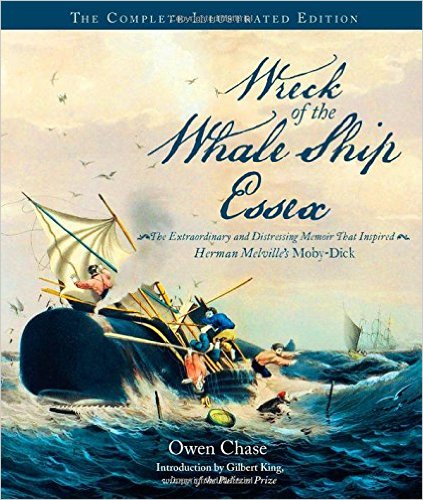Review by Angela L. Eckhart
 On Nov. 20, 1820, an infuriated sperm whale in the Pacific Ocean charged at the whale ship Essex, causing a crew of 20 men to escape into three smaller whale boats. Over the course of ninety-two days of extreme dehydration and starvation, only some survived to tell the story. Less than a year later, in 1821, one of those men, first mate Owen Chase, published his memoir, Narrative of the Most Extraordinary and Distressing Shipwreck of the Whale-Ship Essex, on which Herman Melville based his novel Moby-Dick thirty years later.
On Nov. 20, 1820, an infuriated sperm whale in the Pacific Ocean charged at the whale ship Essex, causing a crew of 20 men to escape into three smaller whale boats. Over the course of ninety-two days of extreme dehydration and starvation, only some survived to tell the story. Less than a year later, in 1821, one of those men, first mate Owen Chase, published his memoir, Narrative of the Most Extraordinary and Distressing Shipwreck of the Whale-Ship Essex, on which Herman Melville based his novel Moby-Dick thirty years later.
Now, in 2015, Gilbert King presents Owen Chase’s memoir in an illustrated hardcover version. Chase’s story is separated into three distinct chapters with essays and excerpts from other sources, including snippets from Melville’s famous novel, articles about other ships attacked by whales, and even records of cannibalism. Additionally, photographs, paintings, maps, and relics are interspersed throughout, offering the reader with remarkable visuals.
Owen Chase, the 23-year-old first mate, chronicled his experience with acute recollection and grave details. The particulars of his tribulations provided for an intense look into the crews’ brief moments of relief and hope, as well as their emotional and physical desperation and suffering. At one point during their journey for survival, they reached land (Henderson Island) where they feasted on birds and peppergrass and hoped to discover fresh water. Chase wrote:
“We had still reserved our common allowance, but it was entirely inadequate for the purpose of supplying the raging demand of the palate, and such an excessive and cruel thirst was created, as almost to deprive us of the power of speech. The lips became cracked and swollen, and a sort of glutinous saliva collected in the mouth, disagreeable to the taste, and intolerable beyond expression. Our bodies wasted away to almost skin and bone….”
After four days on land, and just when they thought they would perish of extreme thirst, some crew members had finally discovered drinking water. On Dec. 26, three of the men remained behind while the others departed, now with casks full of water and any sustenance they could pack onto the boat. The provisions were short-lived, however, after being beaten by uncooperative weather, and they had no choice but succumb to cannibalism after one of the crew died. “We separated his limbs from his body, and cut all the flesh from the bones; after which, we opened the body, took out the heart, and then closed it again—sewed it up as decently as we could, and committed it to the sea.”
Although the language can sometimes be challenging, (such as learning when a whale “stoves” a ship, it means the whale struck the ship), Owen’s literary skills are exemplary, and his story is extraordinary. The additional readings provide for fascinating facts of marine life, ships, and survival skills. For example, turtles can live over a year without food or water, so the crew often stowed hundreds of turtles onboard the whale ships for food, and the head of a whale cannot be penetrated, as it’s “as hard and as tough as iron.” This information about the toughness of the whale’s head is contained in two different excerpts within an additional reading from “An Account of the Arctic Regions, with a History and Description of Northern Whale-Fishery” by Captain William Scoresby. The wording is identical, so it’s reasonable this information is valid, but perhaps this redundancy was simply overlooked during the editing process.
Although this 9 ½ by 11 hardcover book weighs about a pound and is not ideal for traveling, it is an impressive book with its choice of fonts and illustrations. The pictures alone force the reader to pause and peruse the stories told within the paintings, lithographs, and engravings, all depicted of scenes of whale ships being attacked and crew men trying to survive. Most fascinating are the photographs of actual yellowed pages handwritten by Thomas Nickerson, the youngest crew member of the Essex. He was the 14-year old cabin boy, and his sketches on torn paper of the whale attack had been preserved and are on display. Additionally, there are photos of relics from the Essex, such as Chase’s eyeglass case, and there’s a two-page spread about scrimshawing whales’ teeth, with photographs of the artwork. The illustrations of maps and charts document the crew members’ journey.
Aside from the colorful and historical illustrations, it would be easier to read Chase’s memoir in succession if the other readings were included in a separate chapter specifically for additional narrative sources. I found myself having to skip over these inserts in order to continue on with the main story, and then having to go back later to read the remaining literature. Older students, especially those who are studying Moby Dick or the history of whales and whale ships will benefit from this valuable resource. Overall, it is a very handsome book and could make an ideal gift.


